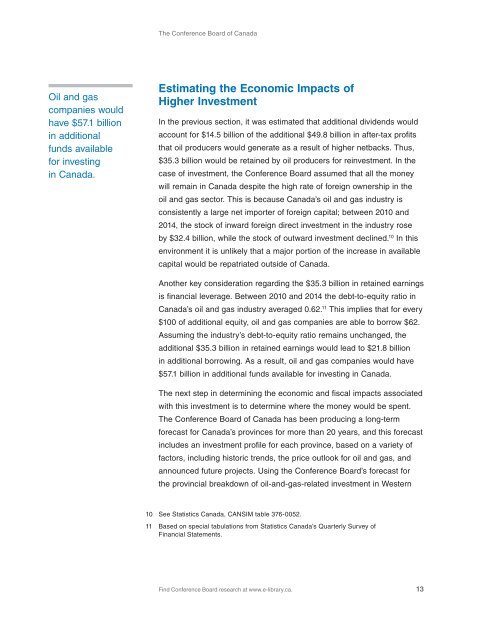Who Benefits?
fnkI300qtdZ
fnkI300qtdZ
You also want an ePaper? Increase the reach of your titles
YUMPU automatically turns print PDFs into web optimized ePapers that Google loves.
The Conference Board of Canada<br />
Oil and gas<br />
companies would<br />
have $57.1 billion<br />
in additional<br />
funds available<br />
for investing<br />
in Canada.<br />
Estimating the Economic Impacts of<br />
Higher Investment<br />
In the previous section, it was estimated that additional dividends would<br />
account for $14.5 billion of the additional $49.8 billion in after-tax profits<br />
that oil producers would generate as a result of higher netbacks. Thus,<br />
$35.3 billion would be retained by oil producers for reinvestment. In the<br />
case of investment, the Conference Board assumed that all the money<br />
will remain in Canada despite the high rate of foreign ownership in the<br />
oil and gas sector. This is because Canada’s oil and gas industry is<br />
consistently a large net importer of foreign capital; between 2010 and<br />
2014, the stock of inward foreign direct investment in the industry rose<br />
by $32.4 billion, while the stock of outward investment declined. 10 In this<br />
environment it is unlikely that a major portion of the increase in available<br />
capital would be repatriated outside of Canada.<br />
Another key consideration regarding the $35.3 billion in retained earnings<br />
is financial leverage. Between 2010 and 2014 the debt-to-equity ratio in<br />
Canada’s oil and gas industry averaged 0.62. 11 This implies that for every<br />
$100 of additional equity, oil and gas companies are able to borrow $62.<br />
Assuming the industry’s debt-to-equity ratio remains unchanged, the<br />
additional $35.3 billion in retained earnings would lead to $21.8 billion<br />
in additional borrowing. As a result, oil and gas companies would have<br />
$57.1 billion in additional funds available for investing in Canada.<br />
The next step in determining the economic and fiscal impacts associated<br />
with this investment is to determine where the money would be spent.<br />
The Conference Board of Canada has been producing a long-term<br />
forecast for Canada’s provinces for more than 20 years, and this forecast<br />
includes an investment profile for each province, based on a variety of<br />
factors, including historic trends, the price outlook for oil and gas, and<br />
announced future projects. Using the Conference Board’s forecast for<br />
the provincial breakdown of oil-and-gas-related investment in Western<br />
10 See Statistics Canada, CANSIM table 376-0052.<br />
11 Based on special tabulations from Statistics Canada’s Quarterly Survey of<br />
Financial Statements.<br />
Find Conference Board research at www.e-library.ca.<br />
13


